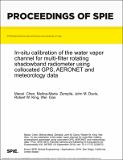| dc.contributor.author | Chen, Maosi | |
| dc.contributor.author | Zempila, Melina-Maria | |
| dc.contributor.author | Davis, John M. | |
| dc.contributor.author | Gao, Wei | |
| dc.contributor.author | King, Robert W | |
| dc.date.accessioned | 2018-06-21T18:23:24Z | |
| dc.date.available | 2018-06-21T18:23:24Z | |
| dc.date.issued | 2016-08 | |
| dc.identifier.uri | http://hdl.handle.net/1721.1/116507 | |
| dc.description.abstract | The difficulty of in-situ calibration on the 940 nm channel of Multi-Filter Rotating Shadowband Radiometer (MFRSR) stems from the distinctive non-linear relationship between the amount of precipitable water vapor (PW) and its optical depth (i.e. curve of growth) compared to the counterpart of aerosols. Previous approaches, the modified Langley methods (MLM), require exact aerosol optical depth (AOD) values and a constant PW value at all points participating the regression. Instead, we propose a new method that substitutes the PW optical depth derived from collocated GPS zenith wet delay retrieval in conjunction with meteorology data and requires a constant AOD value at all points participating the regression. The main benefits of the new method include: (1) Aerosol stability is easier to fulfill than PW stability; (2) AOD stability could be inferred from adjacent channels (e.g. 672 and 870 nm) of MFRSR itself without measurements of a collocated AERONET sun photometer; and (3) When applicable, the time interval of GPS derived PW (i.e. 3 minutes) is more compatible with the MFRSR sampling interval (i.e. 3 minutes) than AERONET interpolated AOD (i.e. 15 minutes). Both MLM and the new method were applied to the MFRSR of USDA UV-B Monitoring and Research Program at the station in Billings, Oklahoma (active for 18 years so far) on July 28, 2015. The performances of the two methods are compared in order to assess their accuracy and the advantages and disadvantages. | en_US |
| dc.description.sponsorship | National Science Foundation (U.S.) (Grant S13-EAR1261833-S4) | en_US |
| dc.description.sponsorship | United States. National Aeronautics and Space Administration (Grant NNX14AQ03G) | en_US |
| dc.publisher | SPIE | en_US |
| dc.relation.isversionof | http://dx.doi.org/10.1117/12.2236572 | en_US |
| dc.rights | Article is made available in accordance with the publisher's policy and may be subject to US copyright law. Please refer to the publisher's site for terms of use. | en_US |
| dc.source | SPIE | en_US |
| dc.title | In-situ calibration of the water vapor channel for multi-filter rotating shadowband radiometer using collocated GPS, AERONET and meteorology data | en_US |
| dc.type | Article | en_US |
| dc.identifier.citation | Chen, Maosi, et al. "In-Situ Calibration of the Water Vapor Channel for Multi-Filter Rotating Shadowband Radiometer Using Collocated GPS, AERONET and Meteorology Data." Proceedings Volume 9975, Remote Sensing and Modeling of Ecosystems for Sustainability XIII, 28 August 1, - September, 2016, San Diego, California, edited by Wei Gao and Ni-Bin Chang, SPIE, 2016, p. © COPYRIGHT SPIE. | en_US |
| dc.contributor.department | Massachusetts Institute of Technology. Department of Earth, Atmospheric, and Planetary Sciences | en_US |
| dc.contributor.mitauthor | King, Robert W | |
| dc.relation.journal | Proceedings Volume 9975, Remote Sensing and Modeling of Ecosystems for Sustainability XIII | en_US |
| dc.eprint.version | Final published version | en_US |
| dc.type.uri | http://purl.org/eprint/type/ConferencePaper | en_US |
| eprint.status | http://purl.org/eprint/status/NonPeerReviewed | en_US |
| dc.date.updated | 2018-03-16T15:52:10Z | |
| dspace.orderedauthors | Chen, Maosi; Zempila, Melina-Maria; Davis, John M.; King, Robert W.; Gao, Wei | en_US |
| dspace.embargo.terms | N | en_US |
| mit.license | PUBLISHER_POLICY | en_US |
